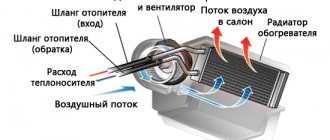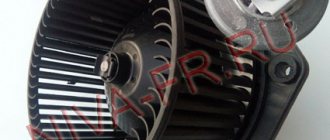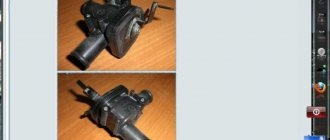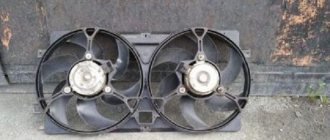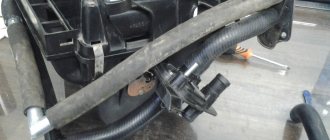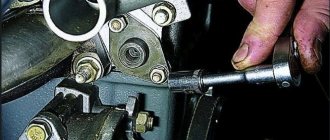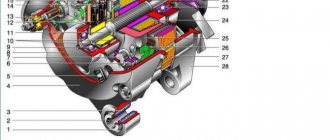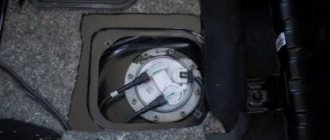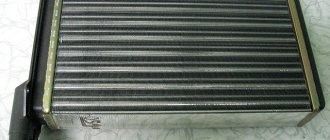Location of the heater fan on the Niva Chevrolet car
On a Chevrolet Niva car, the heater fan is located in the engine compartment under the cabin filter, slightly below the windshield. A motor is installed under the impeller, which is connected through the fuse box to the on-board network of the machine.
The stove fan occupies a central place in the interior heating system of the Niva Chevrolet car.
If necessary, dismantling the motor can be done in two ways:
- through the hole for the cabin filter, having previously removed the filter itself;
- through the interior, partially dismantling the dashboard.
More often they resort to the first option, since it is less labor-intensive.
On the Chevrolet Niva, the heater fan is located in the car interior under the cabin filter
Problem
The question, as always, turned out to be extremely simple - the quality of the original delivery. It turned out that the Chevrolet Niva heater motor was supplied to the conveyor assembly assembled from the Kaluga plant. The official name of PJSC Kaluga Automotive Electrical Equipment Plant is KZAE. This plant, as you know, is almost entirely configured to work with the Volkswagen plant, which is located there, and supplies products to AvtoVAZ only for the assembly line. And even these supplies are not enough and we have to install stove motors from other manufacturers. There is a very big difference, both in the resource of spare parts and in the ease of installation. Of course, the main supplier of the Russian spare parts market is China or Luzar (which is not very important). The motors initially hum very loudly, but most importantly the impeller is pressed onto the motor shaft. While on the Kaluga product it is located on a lock washer, which greatly facilitates the installation and dismantling of the spare part. There is another Tolyatti product, if I’m not mistaken, of a similar design. But with a minimal difference in price, it is better to supply a conveyor original, especially since, as I said earlier, the plant serves Volkswagen.
Symptoms of a malfunctioning stove fan
The main signs of a stove fan failure are as follows:
- the electric motor does not work;
- the rotation speed of the electric motor decreases;
- The fan starts to creak.
Depending on the symptoms that appear, the procedure for eliminating the problem is determined.
The electric motor does not work
If the electric motor stops working, the noise in the cabin disappears when the heater is turned on.
Often the reason for this is the failure of fuse F18 with a rating of 25A in the corresponding block, through which voltage is supplied to the stove motor.
Another reason may be damage to the fan motor winding - if the wire insulation is damaged, an interturn short circuit may occur. In this case, the electric motor must be replaced.
This is interesting: Autonapping
When there is an interturn short circuit, the electric motor stops working.
The rotation speed of the electric motor decreases
When the rotation speed of the motor shaft decreases, it is somewhat more difficult to determine the source of the problem. The noise level becomes noticeably lower as the motor power decreases. This may be due to severe wear on the armature or brushes. In addition, the fan begins to consume much more current, and this can lead to the failure of fuse F18.
If the armature is heavily worn, the electric motor will rotate much more slowly.
The fan starts to creak
The fan begins to creak when the motor bearings wear out. The more wear, the stronger the squeak. If you do not take any action, the heater fuse will burn out and the motor itself will jam. In this case, the electric motor should be replaced with a new one.
If the bearings are worn too much, the engine seizes up.
Replacing the heater fan fuse
Almost any malfunction of the stove motor leads to the replacement of fuse F18. On a Chevrolet Niva car, the fuse box is located in the passenger compartment under the instrument panel and is closed with a cover secured with two self-tapping screws. When replacing F18, it is recommended to check and, if necessary, replace other fuses.
The heater fuse is located in the fuse box under the instrument panel
If fuse F18 has to be changed quite often, then the problem should be looked for elsewhere. There may be a short circuit somewhere in the motor power supply circuit. Sometimes the fuse blows as a result of severe contamination of the cabin filter. In this case, the electric motor does not have enough power for normal air ventilation, and the fuse fails.
Often the cause of the heater motor stopping is a blown fuse.
The suspicious fuse is removed from its seat in the block using special tweezers. If it burns out, a new one is installed in its place. When checking, it is better to use a multimeter, since it can be difficult to visually determine the integrity of the fuse.
The heater fuse on the Chevrolet Niva (F18) is rated at 25 A
Video: replacing the heater fuse
Chevrolet Niva LE+ Full insulation StP › Logbook › Replacing the heater motor
Well, now my turn has come. The fan rustled at 1500-2000 km. I decided to climb (without contacting the dealer - just wasting time and nerves, it's over...) to remove the heater fan. I decided to write my own article about this, because for some reason in other articles that I looked at, they almost remove the torpedo (and some even remove it for some reason) in order to remove the fan. And according to the time they write, it takes 3-4 hours. On the second attempt it took me about 45 minutes to remove/install. The first time I removed/set 1.5 - I just lubricated the motor with silicone grease, but it didn’t help, it rustled again, then I decided to just change the motor to the Kaluga one.
Next, pull out the filter and remove the retaining ring from the fan impeller.
Next, we climb into the car and remove the glove compartment.
We remove the terminals and hose from the engine.
The motor hangs on only 3 screws. You will need a long and a short Phillips screwdriver. Everything unscrews easily - half a minute per screw.
We take 2 screwdrivers and insert them at 90 degrees (more if possible) to each other clearly in the center where the shaft is. And use a lever to throw off the impeller - if you did everything correctly, it will fly off in one step (5 seconds), if you fiddle for 5 minutes, you inserted the screwdrivers incorrectly. (even a specialist took a photo after everything)
Do not lose the key that is inserted into the shaft.
I sharpened the burrs with a file and went over them with a zero. I tested the fan - it did not creak. I sprayed the bearing a couple of times with silicone grease and began reassembling it.
It’s more interesting to assemble =) Firstly, you need to guess the very key in the groove on the impeller - you’ll understand what I mean. Draw a line on the impeller as the groove goes - your assistant will need it. In short, try to get there. We got it right the first time: we installed the groove and key on the shaft “across the machine.” An assistant held the impeller from the street, and I slowly lifted the engine up, guessing the key into the groove.
Replacing the stove fan
Replacing a heater motor is quite simple.
Required Tools
To work you will need:
- set of hex keys;
- Phillips screwdriver;
- new electric heater motor.
This is interesting: About proper care of wipers in winter
Removing the stove fan
The stove fan is removed as follows.
- The negative terminal of the battery is disconnected.
- On the right (in the direction of travel) under the windshield there is a cabin filter protected by a snap-on lid. After removing the cover and removing the filter, access to the heater fan is available.
To access the heater fan, the cabin filter is removed - The impeller is removed. To do this, use a Phillips screwdriver to unscrew the bolt holding the mounting bracket. The impeller moves to the side and is removed.
To remove the impeller, you need to unscrew the bolt and remove the mounting bracket - In the cabin, in front of the passenger seat, the fastening of the glove compartment panel is unscrewed.
To access the electric motor, the glove box panel is removed - The connector with the power wires is disconnected.
To remove the electric motor, you must disconnect the connector with the power wires - Use a short 10mm hex to unscrew the mounting bolts and remove the electric motor.
The heater motor is secured with three bolts - After removing the engine, the impeller is carefully removed through the cabin filter niche.
The impeller can be pulled out freely from the cabin filter side
Installing a stove fan
The faulty electric motor is repaired or replaced with a new one. A damaged impeller should also be replaced. A thin wire is threaded through the holes in its body and the cavity of the cabin filter is secured. The impeller must be installed in such a way that the groove located inside it fits into the pin of the electric motor shaft.
Before installing a new engine, the axle is lubricated with a special lubricant.
Assembly is performed in reverse order. If the impeller does not fit into place, it should be moved several times in different directions until it is completely seated on the motor shaft. Then, under the hood, the wire is cut with wire cutters, the mounting bracket is installed and the bolt is tightened. New heater fan installed.
Thus, diagnosing faults, repairing and replacing the heater fan on a Chevrolet Niva is not very difficult. This will require a minimum set of standard tools. Keep an eye on the stove, and the inside of your car will always be warm.
Chevrolet Niva › Logbook › Winter is coming... Changing the heater fan without removing the dashboard
So, in the previous entry you may have already appreciated how the Shniva’s stove whistles. Let's add to this the fact that repairing something in winter is not the most pleasant pleasure, which is why we replaced the heater motor in advance.
The book says that you need to remove the entire panel and only then replace it, but on the forums they write that you can get by, which is what I did. (in principle, this is no longer a new operation for me


